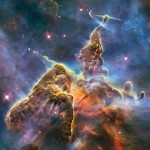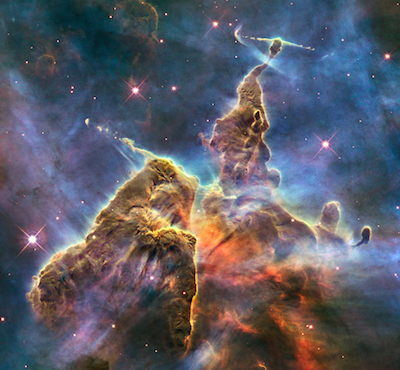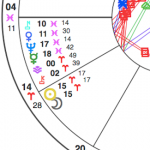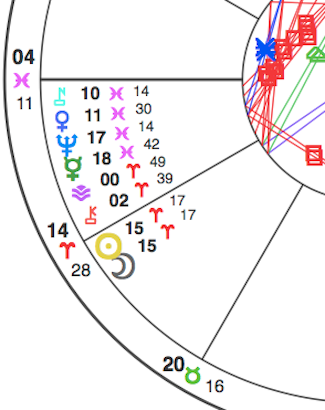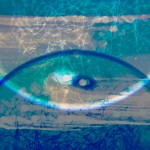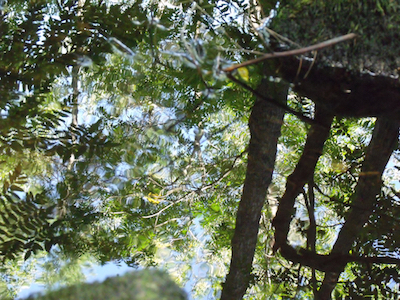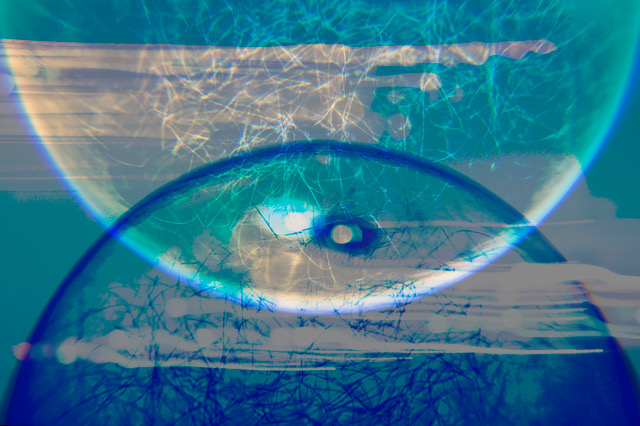
Image by Lanvi Nguyen.
Once upon a time, many years ago, an old, wise, white-haired master of whom I was very fond taught me something. A simple trance technique, used to contact guides and receive information from the higher planes. He called it The Absolution Pool.
He told me to create a temple, create it in the imaginal realm, to invest great care in its construction; visualizing how the light played upon detail, how it felt, how it looked and smelled and sounded. The one essential element was some piece of comfortable furnishing upon which to lie down.
I was to practice lying down within my private temple, and draw energy up from the soles of my feet through the crown of my head, and in so doing to release all worries, fears, and worldly concerns. With each pass upwards through my body he told me to let some of the energy gather within the eye that looks out from the center of my forehead.
He tapped the spot, “Now see before you the sacred pool, and enter the waters from here. The water is pure love… Do you feel it, child? Bathe there; bathe in the waters of purest love and when you are ready, dive down… Down, down. Swim down and down until you see the lights, the lights along the sides of the tunnel. Find the one that calls you, sister, and enter.”
After receiving whatever information or communion sought, I was to remember always to exit from my host’s audience by walking backwards, with respect.
In my temple there is a flame; a perpetual flame in a sacred hearth.
Mystery Play
When I realized Mercury’s retrograde concluded with ten days of conjunction to Neptune, my inner detective snapped to attention. The shadow began on my solar return, Mercury stationed retrograde opposite my ascendant, headed for a deep dive into Neptune, which has been conjunct my Moon for the better part of a year. It felt personal. The recent Pisces cycle had some dramatic astrology; ten days in the belly of the whale, that conjunction with Neptune, makes it extraordinary. Mercury is the bringer of omens: is there a message to be gleaned?
The Players
Looking at the conjunction, symbolism resonant of a kind of soul retrieval leaps out, with Mercury in his role as psychopomp: literally “guide of souls.” Mercury alone among the gods had the ability to traverse all realms: the Olympian upper realm of gods, our human sphere, and Pluto’s underworld. As a guide of souls, Mercury escorted the newly departed across the barrier between realms. He is the god of border crossings. Carl Jung framed the psychopomp archetype as a mediator between the conscious and unconscious, symbolically appearing in dreams as a wise teacher, or helpful animal.
Dreams are Neptune’s purview, all right. Western culture generally values dreaming consciousness in terms of personal psychology, and Neptune’s orbital harmony with Pluto underscores the cosmic truth in this relationship. But that’s pretty much the extent to which our worldview embraces the power of dreams.
Eric referenced the Tibetan Buddhist approach to dreams, known as dream yoga, in the context of this Mercury-Neptune conjunction. Mercury’s relationship with conscious thought, and Neptune’s relationship with the dream world, couldn’t make this more apt. Tibetan adepts train themselves to bring conscious awareness into the dream state, what we call “lucid dreaming.” The skill is thought to be invaluable practice for traversing the Bardo, the state in between incarnations (as Tibetan Buddhism frames reincarnation).
Mesoamerican esoteric tradition preserves similar teachings; for the purpose of transcending karmic patterns, like the Tibetans, as well as for transforming waking experience. When asleep and dreaming, we’re usually aware of no other reality. Likewise, while awake, concerns of the everyday world and personality are ‘reality’.
Within the Toltec worldview, first brought to the mainstream through the work of Carlos Castaneda, the reality glimpsed in dreams is causal: waking reality is created from within that vast domain. The relationship between our two, usually entirely divorced, psychic components — dreaming and waking awareness — plays into the epochal shift identified millennia ago by Mesoamerican astronomer-seers. Their legacy is most familiar in the form of the Mayan calendar, though also preserved in arguably more intact transmissions. That’s too long a story for now, but relevant to what I’ve perceived of the message and potential in this unusual Mercury-Neptune conjunction.
The transcendent, creative inspiration we see in Neptune types like Einstein and Michelangelo may astound us, but poses no threat. We readily cut certain kinds of genius some slack; it’s ok for them to be weird. However, discernment between different otherworldly Neptune functions — psychism, ecstasy, spiritual communion — and psychopathology of whatever sort, is not especially supported by our cultural perspective. Such experiences have never won friends within established orders.
Theresa of Avila, for example, whose ecstatic trances were said to result in inconvenient levitations, came perilously close to the fiery fate of Joan of Arc. Reputable scientists whose research focuses on psychic phenomena, or other Neptune subjects like reincarnation, are rarely embraced by the scientific community, regardless of the impeccability of their methods or quality of their data. Venturing beyond accepted realities, whether religious or scientific, can be a dangerous border crossing.
As a culture, we’ve been stuck in the awkward stage between the doctrinal rigidity of institutionalized religion, and the unacknowledged, yet dominant, religion of ‘scientific’ materialism. Quantum physics may prove the fundamental illusion of linear time and materiality, yet access to the consciousness compatible with that reality remains distant and elusive. Kind of like Neptune.
Contemporary biographies of outstanding mystic saints, like Theresa, often include a psychological diagnosis to explain their symptoms. This is understandable, to a point; for in true Neptunian fashion, the distinction between spiritual or psychic genius and delusional psychotic is sometimes unclear. Charlatans, from time immemorial, have exploited the profound human need for contact with what lies ‘beyond the veil’, and discernment between authentic phenomena and fraudulent illusion can likewise be tricky. Neptune’s jurisdiction is not of this world. The negative potential inherent in Mercury’s conjunction, especially when retrograde (poor judgment, clouded thinking, etc.) has been laid out in these pages for a few weeks.
But what’s the positive potential? Are we presented with an opportunity to grow in any way?
This mystery play features a third player, Vesta, goddess of the Eternal Flame. Vesta’s signature includes the capacity to hold space: sanctuary for private focus and devotion to ideals. Like Mercury’s dominion over border crossings, Vesta guards the threshold.
Vesta is the sacred fire that burns within the Earth, the fertilizing, vital spark of life. Her priestesses were virgin, in the sense of whole-unto-themselves. They prepared official sacrificial offerings, and, consistent with offerings to deities throughout antiquity, represented the ‘finest of the flock’: beautiful maiden daughters of the ruling class. This fiery asteroid (Vesta’s luminous surface composition makes it the only one visible to the naked eye) is associated with both Virgo and Scorpio, symbolic of service, dedication, wholeness and the mystery of generation.
The Astrology
Mercury’s retrograde shadow and first conjunction with Neptune (where it will end up after its backward journey) began on Feb. 19, just after the Sun entered Pisces, on the day of the Virgo Full Moon. The Sun was in the first degree of Pisces, Moon in the first degree of Virgo, with Mercury at 17 degrees Pisces and Neptune at 16 degrees Pisces, just about the middle of the sign.
The retrograde began on March 5, hours before the Pisces New Moon, with Sun, Moon, Neptune and Vesta conjunct at 16-17 degrees Pisces. Mercury stationed retrograde at 30 degrees of Pisces (also written as 29+ Pisces) the last degree of the zodiac; the ‘degree of expiation’.
The exact retrograde conjunction with Neptune on March 24 recurred at 17 degrees Pisces. Venus entered Pisces, the sign of its exaltation, on March 26.
Mercury stations direct on March 28, still conjunct Neptune. That ongoing conjunction to Neptune will be precisely exact again on April 2, at 18 degrees Pisces.
That April 2 exact conjunction between Mercury and Neptune occurs shortly after the Moon conjoins Venus in Pisces, with Vesta now at 30 degrees Pisces (on a chart this appears as 29 Pisces, and can be written as 29+ Pisces). This is exactly where Mercury was when the retrograde began, and opposite Vesta’s discovery degree, 30 degrees Virgo (also written as 29+ Virgo).
The arc highlights the entirety of the Virgo-Pisces axis, with both first and last degrees of those signs activated. The fusion of their planetary rulers, Mercury and Neptune, underscores the significance.
Higher aspirations shared by Virgo and Pisces include service and transcendence of ego identification. The astrological ‘Piscean Age’ has been associated with the rise of Christianity (however quickly and dramatically Rome’s usurpation may have altered the spirit of that movement). Piscean symbolism recurs in New Testament narratives; in the Middle Ages Virgo became associated with Mary, the virgin mother. Neptune is ‘the higher octave’ of Venus. Personal love becomes divine compassion.
The Sabian Symbol for 17 Pisces, the most recurring degree in the arc, where Neptune receives both Mercury and Vesta in conjunction is: AN EASTER PARADE. Dane Rudhyar writes of this degree, “The Image of the Resurrection spurs all men within the pale of Christendom to appear at their very best and to dynamize themselves in some kind of self-renewal in response to the Christ mythos, and to the call of nature’s springtime as well.”
Religious impulse in the broadest sense is Neptune territory: faith, belief, aspiration toward the supramundane. Toss in obedience, and orthodox traditions require little else. Yet Abrahamic religions all have mystic, esoteric schools in which adherents train, in varying ways, higher faculties; guiding the conscious mind into an exalted state from which to contact the numinous. Within gnostic (from gnosis, literally “knowledge,” implying direct cognition of metaphysical truth) Christian tradition, the historically maligned authority was Mary Magdalene, whose report of having seen the risen Christ earned her the distinction “Apostle to the Apostles.” In one heretical text, Mary obliges their request to share her special knowledge:
“I saw the Lord in a vision and I said to him, ‘Lord, I saw you today in a vision.’
He answered, ‘How wonderful you are for not wavering at the sight of me! For where the mind is, there is the treasure.’
I said to him, ‘Lord, does a person who sees a vision see it with the soul or with the spirit?’
The Savior answered, ‘A person does not see with the soul or with the spirit.’ Rather the mind, which exists between these two.”
Mercury traverses all realms. If Neptune is the window that opens to the extraordinary, Mercury is the part of us that looks through it.
I find it interesting, in terms of this remarkable retrograde, that the spring festivals of Passover and Easter fall quite late in the season this year. The lunar cycles that determine their timing delay observance until the third week of April. The inrushing season is, in a sense, held in check; Mercury finally clears its back-end shadow to enter Aries on April 17.
Are we to take something with us into the new season, into the new astrological year, into the future, from this exceptional conjunction — the liminal space between worlds, where human thought and The Beyond are brought into what looks like an arranged marriage? Are we to reunite with some bit of our soul, to hold space for such a journey? Can we hold ourselves at all apart from the noise, the constant distractions of ‘reality’ that hypnotize us into a trance that keeps us from the transcendent?
I think we’re being encouraged to do just that, for good reason.
Accelerating chaos in the outer world requires dedicated focus to all that strengthens our own psychic wholeness, resilience and power. We’re ever more assaulted by stressful, overwhelming data, conflict and disharmony.
We more easily access higher levels of consciousness from a positive emotional state, yet our routine thought patterns make this an increasing challenge. To intentionally release worries and habitual thought loops is a skill that can be developed with discipline and devotion (Virgo, Vesta). Neptune’s highest vibration ripples through the pure love in The Absolution Pool. From there, we can traverse worlds with our mind. These are innate talents we are wise to develop.
We all have guidance available to us. I believe we are being given a sign that it’s time to start making use of it.
“First you dream it, then you live it.” The sequence is familiar in Science of Mind and personal development teachings. Toltec dreamers practice ‘planting a dream’, often with astonishing results. One needn’t be versed in Toltec tradition to understand the power of creative visualization, however. The threshold to our psychic depths, where hypnotic suggestion meets conscious creation on the imaginal plane, is the sweet spot where Mercury dives into Neptune for a swim.
More and more, conditions in the world encourage habitual inner dialogue that reinforces what amounts to a tiny fraction or our identity. To strive past that does involve an element of humility. When we do, we serve our own healing process and that of others (Virgo/Pisces).
Structures that support outer realities as we have known them are, indeed, transforming. We’re in a pivotal time; a threshold between worlds. Time itself feels dreamlike, and events blaring in our faces seem surreal.
Transcending karma, which is mostly momentum of repetitive patterns, is necessary.
To change the dream, we must wake up within it.
That’s what lucid dreaming’s all about.
Believe it.





